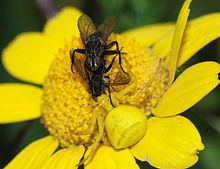Ambulance hunters

Crocodile in the murky water while stalking

A mutable crab spider disguised as part of a flower lurks for a fly
In biology, carnivorous animals or plants that lurk more or less in one place for prey are referred to as ambulance hunters , more rarely also as hide hunters . If the camouflage is achieved by imitating inanimate objects or harmless organisms, one speaks of mimesis . The success of the stalking hunt is essentially based on the surprising overpowering of the prey.
Some predators use chase as well as ambush ; Provided there is a sufficiently high number of prey, the advantage of ambush hunting lies in the lower energy consumption.
Examples
Ambush hunters can be found among the mollusks , arthropods , vertebrates and other groups of animals. Some examples:
- Mammals: cats that hunt individually are predominantly categorized as ambulance hunters. On the other hand, cats and dogs hunting in packs are more likely to be hunters .
-
Birds: The term "hide hunter" is mostly used for birds. The attack comes from a seat guard , for example the branches of a tree. Examples are kingfishers , hawks and kestrels , which, in addition to high-seat hunting, also use aerial hunting , which, however, is quite exhausting due to the shaking flight used .
 A Jule as an artificial seat guard for birds of prey to facilitate hunting
A Jule as an artificial seat guard for birds of prey to facilitate hunting - Reptiles: Chameleons , snapping turtles and crocodiles are stalkers, crocodiles, depending on the circumstances, also hunters.
- Bone fish: Frogfish are an example of ambulance hunters who use a lure method.
- There are also lurker hunters among the crustaceans , such as the mantis shrimp .
- Arachnids: Many hunting techniques have been developed by arachnids , including various stalking methods: trapdoor spiders and articulated spiders lurk in their living tubes for contact signals from their alarm and trip threads. Wallpaper spiders build a well-camouflaged catch hose and lurk in their living tube. Funnel spiders lurk for prey in a ground funnel lined with silk. Crab spiders or jumping spiders do not use spun tools in their stalking hunt.
- Insects: Juvenile ant lions lurk for prey like ants in a sand funnel they have dug themselves. Terrors are diurnal ambulance hunters.
- Many beetle snails are also predatory hunters.
See also
literature
- Peter Kappeler: Behavioral Biology , Berlin 2006, ISBN 3-540-24056-X .
- Ralf Wassmann: Ornithological Pocket Lexicon ; Aula-Verlag; Wiesbaden 1999; ISBN 3-89104-627-8
Web links
Wiktionary: Lauerjäger - explanations of meanings, word origins, synonyms, translations
Individual evidence
- ↑ Colin R. Townsend, Michael Begon, John L. Harper: Ecology (= Springer textbook ). 1st edition. Springer, 2003, ISBN 978-3-662-09048-0 , ISSN 0937-7433 , p. 329 , doi : 10.1007 / 978-3-662-09048-0 (English: Essentials of Ecology . 2002. Translated by Thomas S. Hoffmeister, Johannes Steidle, Frank Thomas).
- ^ Matthias Schaefer: Dictionary of Ecology . 5th revised and expanded edition. Spektrum Akademischer Verlag, Heidelberg 2012, ISBN 978-3-8274-2562-1 , p. 136, 156 ( limited preview in Google Book search).
- ↑ Colin R. Townsend, Michael Begon, John L. Harper: Ecology . 2nd Edition. Springer-Verlag Berlin Heidelberg, Berlin, Heidelberg 2009, ISBN 978-3-662-44077-3 , pp. 270 f., 294 , doi : 10.1007 / 978-3-662-44078-0 ( limited preview in Google Book Search [accessed on October 19, 2019] English: Essentials of Ecology . Oxford 2008.).
- ↑ Kappeler
- ↑ Wassmann